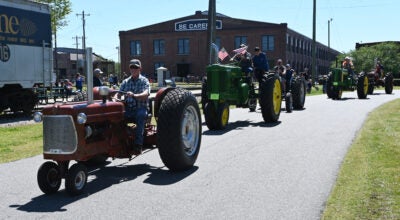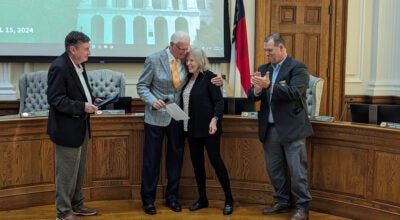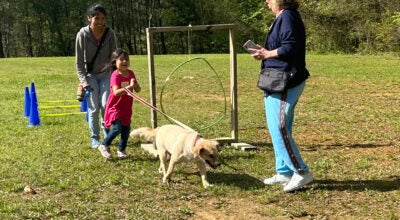Aviation buff calls Richfield home
Published 12:00 am Monday, June 20, 2011
RICHFIELD — Floyd Wilson can hardly believe the story himself.
Some 25 years ago, he had hired Matt Coble to refinish some floors for him. As he worked, Coble couldn’t help but recognize Wilson’s love for aviation history, judging from all the memorabilia around the house.
One day Coble mentioned having in his possession a World War II flight bag that had belonged to his brother Warren, an Albemarle attorney. Would it be something Wilson might be interested in?
The green canvas bag contained the full flight gear Warren Coble wore as a radio operator on bombing missions in the Pacific. Matt Coble said his brother flew on the B-29 “Necessary Evil,” the photography plane for the mission that dropped the atomic bomb on Hiroshima, Japan.
“That’s probably the favorite thing I have,” Wilson says, nodding to a mannequin clothed in Warren Coble’s full gear.
For Wilson to cherish the flight gear of Warren Coble over everything else says a lot. Wilson co-founded the Carolinas Aviation Museum in Charlotte and arguably has the most incredible private collection of aviation art and signed memorabilia in the country.
He has art, photographs, posters, airplane models, magazine covers, stories, caps, plaques and aviation artifacts in virtually every room and hallway of his Richfield home. Scores of others are waiting to be framed or displayed as museum-type pieces.
The signatures alone will stop any aviation enthusiast in his tracks — Gregory “Pappy” Boyington, commander of the Black Sheep Squadron; Robert Morgan, World War II flying ace and pilot of the Memphis Belle; Chuck Yeager, who broke the sound barrier; Scott Crossfield, the test pilot who flew twice the speed of sound; and James H. “Jimmy” Doolittle, famous for leading the B-25 bombing raid on Tokyo in 1942.
But that only scratches the surface. He has autographs from the Enola Gay crew, including pilot Paul Tibbets and bombardier Tom Ferebee, a Mocksville native. Actor Jimmy Stewart signed a rare Life magazine cover that pictured Stewart when he served as a World War II pilot.
Vietnam ace Steve Ritchie has signed other pieces.
On upstairs walls are the signatures of President George Bush (the first Bush) and Buzz Aldrin, the second man on the moon. Floyd Wilson stands in many of the photographs, including some taken most recently with Capt. Chesley Sullenberger, pilot of the “Miracle on the Hudson” Flight 1549, now on permanent display at the Carolinas Aviation Museum. (See the accompanying story.)
His upstairs office has one of the most extensive libraries of aviation books. The ones signed by the authors are specially marked.
Air Force veteran
A native of Greenville, S.C., the 69-year-old Wilson finished high school in 1959 and immediately joined the Air Force for a four-year hitch. His love of aviation began in destinations such as the Philippines, Italy, Vietnam and Myrtle Beach bases, where he served as crew chief on F-100 and F-102 fighter aircraft.
He used the GI bill to obtain his own pilot’s license as a private citizen. Later, as a life member of the Commemorative Air Force, he was able to fly many of the aircraft now showcased throughout his home — among them, the B-29, B-17, B-24, Stinson Reliant and Navy Avenger.
Meanwhile, he owned TRS Building Products Inc. a company which supplied the manufactured housing industry until its closing in 1999. Along the way, he also raised seven children — his daughter Tammy Myers works at the Rowan County Register of Deeds office — and served four terms as Richfield mayor between 1996 and 2006.
While successful, Wilson’s radiation treatment for throat cancer affected his speech, but he learned to communicate pretty well.
His collecting of aviation art began in the early 1980s, and Wilson made it a point to gather limited prints and original works of art that were signed by the artists, aces or other “aviation notables,” he says.
Wilson and his third wife, Lois, founded the Carolinas Aviation Museum at Charlotte Douglas International Airport in 1992. It sprung from their formation with a handful of friends of the Carolinas Historic Aviation Commission, for which Wilson served as president and chairman until 2007, the year Lois died.
Today the commission has more than 10,000 members. The aircraft restoration facility and museum, which has more than 70 aircraft on display, find their home in the airport’s first two hangars, including the original 1936-37 Southern Airways hangar.
Wilson remembers going to Airport Manager Jerry Orr when he and Lois heard the airport’s original hangars were scheduled for demolition. The neglected first hangar was being used for storage. It was covered in kudzu, had rusted-open doors off their tracks and most of the windows were knocked out.
“I said it should be saved, and I said, ‘Do you mind if I try?’”
Orr was encouraging but told Wilson, “You’re on your own.” as far as any funding and restoration help went.
Floyd, Lois and their friends formed work groups, and the couple were traveling almost every day from Richfield to the airport to bring the hangar(s) back to life. Meanwhile, the commission they had founded also worked on bringing planes and other aviation artifacts into the fold.
“Both of us loved history,” Floyd said of Lois and himself. “But without Lois, I could not have done it.”
The museum’s prize acquisitions include aircraft such as a Douglas DC-3, used by Piedmont Airlines in its early days; the Grumman OV-1D Mohawk battlefield and reconnaissance plane; and now the “Miracle on the Hudson” plane.
It was through membership in numerous aviation associations and his trips and duties for the museum that Wilson also was able to become friends with many aviation heroes and pioneers. As he goes through his house, he calls most of those people his friends.
“I’ve met many fantastic people through aviation,” Wilson adds.
He has, for example, aviation art signed by all members of Doolittle’s Tokyo Raiders and crew members of the Memphis Belle. He has signed memorabilia from the Enola Gay crew, including Tibbets, Ferebee, navigator Theodore Van Kirk, tail gunner George Caron and radio operator Richard H. Nelson.
His twin brother, Lloyd, served an official pallbearer for the April 17, 2004, memorial service held for the crew members of the sunken Confederate submarine H.L. Hunley. Lloyd gave Floyd the white gloves and dolphine he wore as part of that ceremony.
Floyd Wilson’s military collection doesn’t stop there. In outbuildings, he opens the doors to four treasured vehicles, which have seen action in veterans parades throughout the region.
The collection includes a 1953 Korean War ambulance, a 1941 Plymouth Deluxe staff car and two Jeeps. On holidays, Wilson often brings out the vehicles for display in his driveway.
Back in the house, Sgt. Warren Coble’s flight bag sits in the corner of the downstairs room that is essentially Wilson’s own aviation museum.
Wilson confirmed everything Matt Coble told him by later speaking with the crew’s navigator. Sgt. Warren Coble belonged to the 393rd Bomb Squadron. On Aug. 6, 1945, he flew with the Necessary Evil on the first atomic bomb mission — the one in which the Enola Gay dropped the bomb.
On Aug. 9, Coble and his crew were on the Enola Gay, as it served as the advance weather plane on the mission that dropped the second atomic bomb, this time on Nagasaki.
Coble’s B-29 crew was the only one to fly both atomic bomb missions and was on the last combat mission flown by the Enola Gay. If a third atomic bomb had been dropped, Coble’s crew would have been the one to let it go.
And there, on display in Wilson’s home, is the flight gear worn by radio operator Coble on both atomic bomb missions.
Wilson’s collection speaks for itself.
Contact Mark Wineka at 704-797-4263, or wineka@salisburypost.com.




